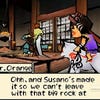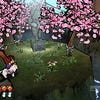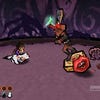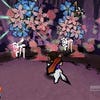Okamiden
Wolf parade.
Your companions have proven to be the most significant gameplay development for Okamiden, says Eshiro. "The partners opened up a whole new world for us. We could add all sorts of different puzzle elements and contraptions and enemies to fight that you can use your partners to get around.
"They're not just a game design element, they are an integral part of the story. The way that they are involved with the plot opens it up in whole new directions. The story differs entirely from the original Okami – it's s different sort of tale, about meeting people, growing with them and sometimes having to say goodbye to them. I think that's where the game really differs from its predecessor."
After five minutes battling the Witch Queen we jump ahead to a flooded temple, where Chibiterasu meets Nanami the mermaid. You can direct her through flooded areas with the Celestial Brush – the ink bleeding into the watery background – whilst the wolf-pup waits on dry land. The soundtrack is wonderful – frog croaks and the sound of distant waterfalls against a backdrop of lively traditional Japanese music.
Perspective changes freely and naturally from top-down to side-on to a more conventional 3D-adventure viewpoint, depending on what's clearest. When you're directing your partner, it tends to offer a more two-dimensional viewpoint; during fights, the camera is right behind Chibiterasu's furry ears.
The game is always astonishingly beautiful to look at. Thick black brush strokes define broad swathes of vibrant colour, the scenery instantly frozen at the touch of a button to become a canvas for the Celestial Brush.
"I wanted to really communicate the Japanese aesthetic and art style to the world," says Matsushita. "There are a lot of elements in this game that reflect Japanese fairytales, and people in Japan who are familiar with them will recognise that.
"But the focus is never really on this folklore... the point of Okami is its fantastical setting, the living world that it inhabits. It incorporates Japanese mythology but doesn't force it upon you."
If Okami had one major fault, it's that it was too long. Far before the end it began to feel bloated, overstuffed with side-missions and collectible treasures, and even the most incredible games struggle to surprise and impress you consistently for more than 50 hours.
Okamiden, as a handheld game, is unlikely to be as vast, but it's just as rich. Every tree can still be brought into bloom with a swish of the celestial brush; there are still huge, open areas to explore, split up into sections that the DS can manage by unobtrusive portals; there are still tens of different items and trinkets to be found in chests and pots or salvaged from the game's abstract, theatrical enemies.
Okamiden is clearly a labour of love. But is it one that Eshiro expects will sell, given the series' history and its distinctively Japanese nature? "One of Capcom's policies is bringing games to market that have a global appeal," he says.
"But we also have games that have that Japanese flavour to them, like Asura's Wrath, and it's things like that that make me feel that all our ideas are not gone yet, and we still have a lot to contribute. We have a lot of different directors with different visions – for Matsushita-san, here, this is the game that he wanted to bring to the world – but there are others who have something to offer."
Okamiden is the kind of game that gives you faith in Japanese game development, a game both born of and soaked in rich cultural tradition, but not restrained by it. It's inventive, playful, funny, and despite the fact that it's a sequel, it's brimming with creativity and ideas – and that sumptuous art style is no less enchanting on a smaller screen.
DS exclusive Okamiden was released in Japan on 30th September and will be out in the US and Europe in early 2011.










